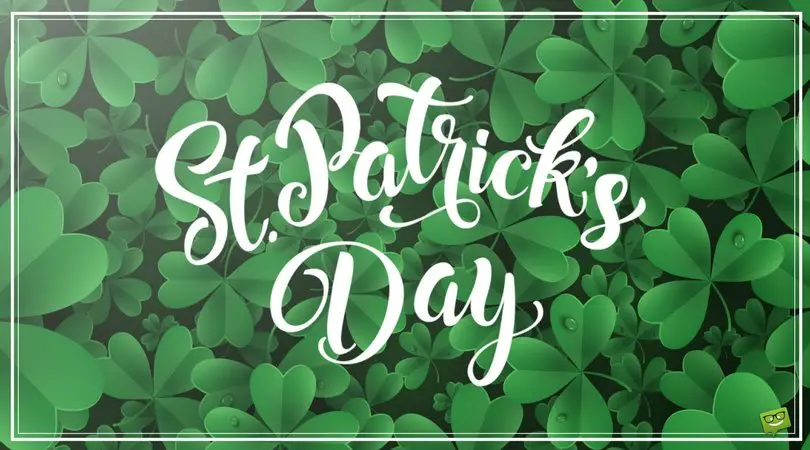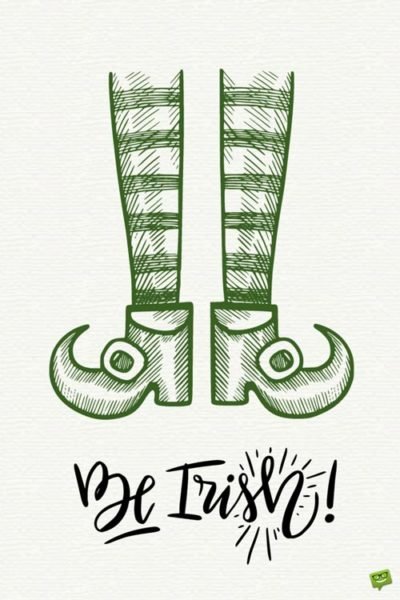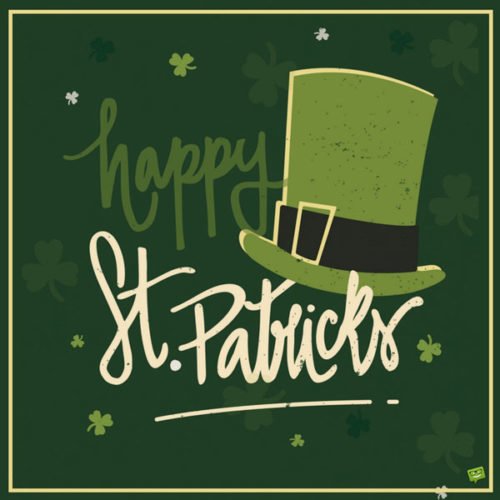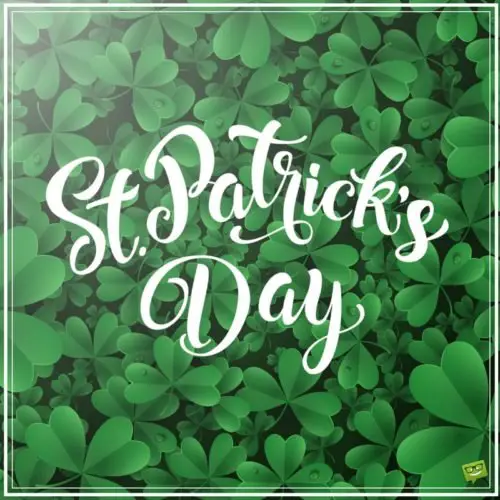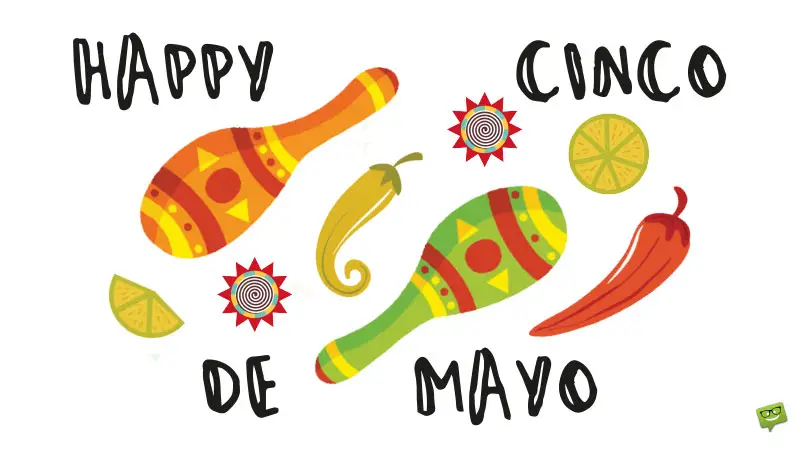Observed globally on March 17 every year, St. Patrick’s Day (also known as the Feast of Saint Patrick) is one of the most famous annual religious celebrations in the world.
On this page we have a reservoir of beautifully crafted St. Patrick’s Day greetings that you can share with friends and family members as you celebrate this special day in the Christian calendar.
Table of Contents
- Why do we celebrate Saint Patrick’s day?
- Happy St. Patrick’s Day Wishes!
- Happy St. Patrick’s Day Wishes for a Friend of Irish Descent
- Happy St. Patrick’s Day Wishes for Mom
- Happy St. Patrick’s Day Wishes for Dad
- Happy St. Patrick’s Day Wishes for my Brother
- Happy St. Patrick’s Day Wishes for my Sister
Why do we celebrate Saint Patrick’s day?
St. Patrick (387 – 461) is one of Ireland’s patron saints. Ironically, he was born in Britain somewhere south of Hadrian’s Wall. He was kidnapped and enslaved by Irish pagans while still a teenager. After escaping, he studied at different monasteries and became a priest. Pope Celestine I sent Patrick to Ireland as a missionary.
At that time, the Irish followed pagan religious traditions, and Patrick sometimes ran afoul of the druids, who were the resident religious leaders. Patrick eventually made headway, and Ireland’s first cathedral and primatial see were built in Armagh by 444. While King Laoghaire (reigned 428 – 458) did not convert to Christianity, some of his children did.
Patrick worked in Ireland for not quite 30 years. He traveled the country and baptized new converts and ordained priests. He also oversaw the construction of monasteries and schools. When he was older, he wrote the autobiography “Confessions.” He died on March 17, 461 and was buried in what is now Northern Island.
The Irish had started to celebrate March 17 as a combination of national day and feast day for St. Patrick by the 9th or 10th century. Luke Wadding (1588 – 1657) was a Franciscan scholar from Waterford, Ireland, and he wanted the Catholic Church to make St. Patrick’s Day an official part of the liturgical calendar, which they did sometime in the 17th century. The Church, however, will change the date if March 17 falls within Holy Week. For example, they held St. Patrick’s Day on March 15 in 2008.
Other churches, including the Church of Ireland, Lutheran Church, and the Eastern Orthodox Church, also declared St. Patrick’s Day to be a feast day. The churches treated St. Patrick’s Day as a time to celebrate the arrival of Christianity to Ireland and honor Irish culture. As a result, the holiday spread throughout Europe.
When Europeans, especially the Irish, settled in places like North America and Australia, they brought their traditions with them – including St. Patrick’s Day celebrations. The first known St. Patrick’s Day parade, for example, took place in 1762 in New York City. There, Irish soldiers serving in the British military marched through the city streets. Their parade allowed them to celebrate their musical traditions and otherwise reconnect with their roots.
Over the next few decades, parades on St. Patrick’s Day gradually became a tradition as Irish immigrants expressed pride in their culture. Many participants played bagpipes. In 1848, several groups got together to form one official New York City St. Patrick’s Day parade. That parade is still held today and now has around 150,000 participants, which makes it the largest St. Patrick’s Day parade in the US and the largest civilian parade in the world.
Today, St. Patrick’s Day is celebrated all over the world. It has even been celebrated onboard the International Space Station. In 2011, Catherine Coleman, an American astronaut with Irish ancestry, played a flute and a tin whistle belonging to an Irish musical group called the Chieftains. Two years later, the Canadian astronaut Chris Hadfield honored the holiday by wearing green and taking pictures of Ireland. He also posted a recording of himself singing “Danny Boy.”
Happy St. Patrick’s Day Wishes!
- Sending you my warmest wishes on this St. Patrick’s Day. I hope you are blessed with a truly delightful life.
- I wish you the choicest of Irish blessings as you celebrate this special day. Happy St. Patrick’s Day!
- As you put that bottle of green beer to your lips, know that that you will become greater in all spheres of your life. Wishing you the happiest St. Patrick’s Day celebration ever! Have a blessed life.
- May the beautiful face of the sun always be present in your world as you observe this St. Patrick’s Day with your loved ones.
- On this auspicious day, I pray that God will soak your life in a river of Irish blessings. Have a wonderful St. Patrick’s Day.
- Here’s a toast to a magical life filled good fortune. Wishing you a Happy St. Patrick’s Day. Enjoy every moment of this super green day.
- On this St. Patrick’s Day, I wish you a long healthy and long life. Have an absolutely wonderful day.
- This is a beautiful day! Forget about all your problems and enjoy the enormous blessings that come with this St. Patrick’s Day!
- Yay! It’s 17th March once again! May our celebration of this great day be accompanied by oceans of happiness, blessings and green beer. Happy St. Patrick’s Day.
- May your St. Patrick’s Day be as beautiful and bright as sunflowers in the middle of summer. Enjoy this Feast of Saint Patrick to the max!
- May real happiness completely take over your life today. Happy St. Patrick’s Day!
- Happy St. Patrick’s Day to a wonderful person. May this day cause your heart of gold to sing with joy.
- Wishing you an incredibly fabulous St. Patrick’s Day. My prayer for you today is that you enjoy a fine bottle of green beer and a lifetime of happiness.
- As you observe this very important day, I pray that your life will overflow with an ocean of Irish blessings. Have a truly glorious St. Patrick’s Day.
- May good fortune be your best friend and companion until the end of time. Happy St. Patrick’s Day.
- Wishing someone dear to my heart a Happy St. Patrick’s Day! May all the Irish luck in the world be yours on this great day.
- We might not be rich, but we are blessed with things that no amount of money can ever buy – life and good health. We shall therefore celebrate St. Paddy’s Day like billionaires. Happy St. Patrick’s Day, my dear.
- Happy St. Patrick’s Day! On this day, may the good Lord bless you with the luck of the Irish and make your grass greener and greener.
- May your blessings be more plentiful than all the whiskey and beer in the world. I hope you have a truly happy and blessed St. Patrick’s Day.
- As we mark St. Paddy’s Day, let’s wear shamrocks and rescue any Irish beer and whiskey trapped in a bottle! I hope you enjoy this Feast of Saint Patrick to the max!
- Dearest, may this day bring your more good luck and fortune than a garden full of four-leaf clovers. Happy St. Patrick’s Day.
- The best way to celebrate St. Patrick’s Day is to spend the entire day with you. I love you so much. Happy St. Patrick’s Day, my dear one.
- Hurrah! St. Patrick’s Day is here again! Wear green, drink an ocean of green beer, and have all the fun in the world with friends and family. That’s what this amazing day is all about! Happy St. Patrick’s Day to you!
- Wishing the most wonderful of St. Patrick’s Day celebrations to the most wonderful woman/man in my life. I hope the blessings you receive today follow you until the end of time.
- Just like St. Patrick’s Day is accompanied by green beer and shamrock, so also may your life move hand in hand with great blessings. Happy St. Patrick’s Day.
- In honor of St. Paddy’s Day, thou shalt dress thyself in nothing but shamrocks or green attire and have as much fun as possible with a glass of green beer in thy hand. Happy St. Paddy’s Day.
- God created the world in six days, and on the seventh day, He instructed the Irish to make Irish whiskey. Let’s drink to that! Happy St. Patrick’s Day!
- On this wonderful and super green St. Patrick’s Day, it’s my prayer that all the empty pots in your house will be brimful with gold.
- My dear, the only place you’ll be spending your St. Patrick’s Day is in the most special place in the cell of my heart. I love you. Happy St. Patrick’s Day.
- May every sip of sip of Irish whiskey bring blessings into your life. Have a wonderful St. Patty’s Day.
- By all accounts, this is the greenest day of the year. So put on your greenest attire and get yourself some green beer let’s celebrate this beautiful day. Happy St. Paddy’s Day!
- Have an incredibly fabulous St. Patrick’s Day! May God bless you abundantly, and may these blessings be multiplied by a thousand and follow you until the end of time.
- May your blessings be as abundant as the shamrocks of Ireland. Happy St. Patrick’s Day.
- Wishing you a blessed and delightful St. Patty’s Day. May happiness and a flood of Irish luck fill your home to the brim. Enjoy your day.
- You are a wonderful person who deserves only the finest treasures in the world. I pray that your St. Patrick’s Day celebration will be nothing short of blessed. Have a happy life, my dear.
- There’s no better day to be Irish than this wonderful day. Happy St. Patrick’s Day to all my amazing Irish friends as well as my non-Irish friends wishing they were Irish. May this day bring you happiness, good health and great success.
- May the love and blessings of God accompany you wherever you go. Happy St. Patrick’s Day.
Happy St. Patrick’s Day Wishes for a Friend of Irish Descent
- On this beautiful St. Patty’s Day, I pray that the strength and love of God will pilot you throughout your earthly journey. Have a truly fabulous day.
- Today, you have countless of reasons to be proud of your heritage! As you observe this great day, may the showers of the heavens fall softly upon your fields and make them evergreen. Happy St. Patrick’s Day.
- Did you know it is super green days like this that I become green with envy that I don’t have a drop of Irish blood in me like you do?! Anyway, Happy St. Patrick’s Day to you from your green-eyed monster of a friend!
- Dear friend, today we shall drink green beer in honor of your great ancestor, the Apostle of Ireland! Happy St. Patty’s Day.
- May your life be caressed by the Irish hills and blessed by the Irish rivers. May the mighty hand of God protect and guide you all the days of your life. Happy St. Patty’s Day, my amazing Irish-blooded friend.
- May the soft mantle of God be upon you today and forever. Happy St. Patty’s Day.
- This is definitely one of my favorite occasions of the year as it is gives us the opportunity to drink as much green beer as our stomachs can contain. Happy St. Patty’s Day to you, my dearest friend. May the blessings of greener fields be yours this day forward.
- May the blessings and luck of the Irish surround you not only on this beautiful day but also on every blessed day of your life. Happy St. Patty’s Day.
- May the amazing blessings of St. Patrick be with you until the end of time. Happy St. Patty’s Day.
- Happy St. Patty’s Day to a wonderful friend. Wishing you barrels upon barrels of blessings and happiness.
- Dear friend, I can’t think of anyone more qualified than you to receive all the blessings of the Irish on this special day! Have tremendously happy and blessed St. Patrick’s Day.
Happy St. Patrick’s Day Wishes for Mom
- Mom, may this special day bless you handsomely for all the tremendous love you have shown me over the years. Happy St. Patrick’s Day to the sweetest mother in the world.
- My dearest Mother, for being an outstanding mother to me all my life, I pray that all the blessings of St. Patrick will be bestowed upon you today. Happy St. Patty’s Day.
- Happy St. Patty’s Day, Mother. May happiness be yours this glorious day and for evermore.
- Wishing a wonderfully blissful St. Patrick’s Day to an amazingly loving mother. Love you so much, Mom.
- Happy St. Patty’s Day to you, Mom dearest. My prayer for you today is that your blessings will be more abundant than all the beer in Ireland.
- Dearest Mother, we pray that your St. Patty’s Day will be as phenomenal as you are to your children. May God forever protect and direct you all the days of your precious life. Have a blessed and merry St. Patty’s Day.
- May the choicest of Irish blessings be showered upon your life today so that happiness, good health and great fortune may always walk with you. Happy St. Patrick’s Day.
- Mom, on this day I pray that God’s blessings will surround you like water surrounds the island of Ireland. Happy St. Patty’s Day.
Happy St. Patrick’s Day Wishes for Dad
- May God bless you abundantly and make you poor in misfortunes. Happy St. Patrick’s Day.
- Happy St. Patty’s Day, dearest Father. May all the goodness that accompanies this great day find their way into your life.
- Dad, you’ve always been there to support and encourage me through thick and thin. This special day gives me a perfect opportunity to not only thank you but also pray for God’s blessings to be part of your life until the end of time. Thanks for all these years of being an awesome father. Happy St. Patrick’s Day, Dad!
- You are an exceptionally wonderful father who deserves nothing short of everlasting happiness. Happy St. Patty’s Day, sweet Father.
- As you enjoy your pints of beer today, may God bestow on you His amazing grace. Happy St. Patrick’s Day to the most wonderful man in my life.
- Wishing a super duper Happy St. Patrick’s Day to the world’s coolest father. May every single day of your life be as wonderful as the taste of green beer in the mouth. Enjoy your day.
- Father, in whatever you do or wherever you go, may the incredible luck of the Apostle of Ireland keep you company. Have a fantastic St. Patrick’s Day.
Happy St. Patrick’s Day Wishes for my Brother
- Happy St. Patrick’s Day, sweet brother. May the good Lord forever make the grass that you walk on as green as emeralds. Love you.
- May God almighty never make you lack greens. Happy St. Patrick’s Day.
- Brother, tonight by hook or crook we shall drink beer and make everything we come across green! Happy St. Patty’s Day!
- Dearest brother, may this day bestow upon your life blessings more plentiful than all the shamrocks that grow on the amazing island of Ireland. Have a truly beautiful St. Patty’s Day.
- Happy St. Patty’s Day, dearest brother! For being the best brother in the world, you deserve all the hugs, love and barrels of green beer in the world.
- Wishing you tons of Irish blessings this St. Patty’s Day. As you make merriment today, do know that having a brother like you is one of my biggest joys of life.
- Happy St. Patrick’s Day. I wish you an abundance of happiness and beer on this day.
- This St. Patrick’s Day, I wish you oceans of Irish blessings and love. May all the happiness you have put into my heart be bestowed upon you this day. Love you lots!
Happy St. Patrick’s Day Wishes for my Sister
- Wishing you good health, good luck and true happiness this St. Patrick’s Day. And may that happiness follow you all the days of your life. I love you.
- I can’t express how lucky I am to have you as my sister. I hope your St. Patrick’s Day is as wonderful as you are. Thank you for being such an amazing sister and friend to me. Happy St. Patty’s Day.
- Sweet sister, have yourself a great and blessed St. Patrick’s Day. Remember that I love you bunches.
- May all the blessing in Ireland fall upon you today. Happy St. Patty’s Day, dear sister.
- Let us enjoy this St. Patty’s Day to the max with some pints of chilled beer, for St. Patty’s Day is no good without beer! I hope you don’t drink too much and forget how much I love you, though!
- For every storm in your life, may God bless you with oceans of rainbows. May you receive an answer to every prayer. I hope you have a gloriously fabulous sweet St. Patty’s Day.
- Happy St. Patty’s Day, sister dearest. May this enchanted day bring you more happiness and Irish blessings than your wonderful life can contain.
You may also like:
40 Ways to Say Happy Birthday on St. Patrick’s Day
